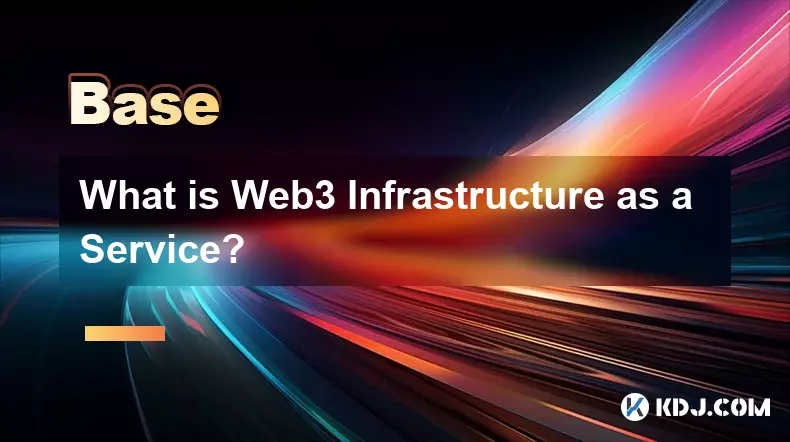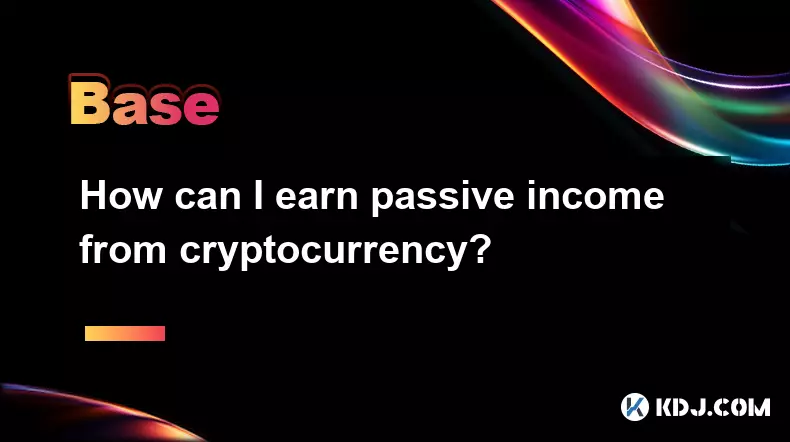-
 bitcoin
bitcoin $112587.146396 USD
-1.85% -
 ethereum
ethereum $4196.799053 USD
-3.32% -
 tether
tether $1.000757 USD
0.03% -
 xrp
xrp $2.848934 USD
-2.53% -
 bnb
bnb $991.371259 USD
-4.28% -
 solana
solana $219.129492 USD
-6.17% -
 usd-coin
usd-coin $0.999827 USD
0.01% -
 dogecoin
dogecoin $0.240658 USD
-3.82% -
 tron
tron $0.340257 USD
0.39% -
 cardano
cardano $0.822447 USD
-5.16% -
 hyperliquid
hyperliquid $46.316869 USD
-6.95% -
 chainlink
chainlink $21.624745 USD
-3.35% -
 ethena-usde
ethena-usde $1.001645 USD
0.13% -
 avalanche
avalanche $33.431900 USD
4.90% -
 sui
sui $3.367253 USD
-4.55%
What is Web3 Infrastructure as a Service?
Web3 IaaS provides scalable, secure, and cost-efficient infrastructure for building dApps with managed nodes, APIs, and decentralized storage.
Sep 20, 2025 at 05:37 am

Understanding Web3 Infrastructure as a Service
1. Web3 Infrastructure as a Service (IaaS) refers to cloud-based solutions that provide developers with the tools and resources needed to build, deploy, and manage decentralized applications (dApps). Unlike traditional web infrastructure, Web3 IaaS is designed to support blockchain protocols, smart contracts, and peer-to-peer networks. These services eliminate the need for developers to run their own nodes or maintain complex backend systems.
2. By offering modular access to blockchain networks like Ethereum, Solana, or Polygon, Web3 IaaS platforms allow seamless integration of decentralized technologies into modern applications. Developers can query blockchain data, send transactions, and interact with smart contracts through simple APIs without deep knowledge of node management.
3. One of the key benefits of Web3 IaaS is scalability. As dApps grow in user base and transaction volume, infrastructure providers automatically scale resources to meet demand. This ensures consistent performance even during periods of high network congestion on blockchains.
4. Security is another major focus. Reputable Web3 IaaS providers implement multi-layered protection mechanisms including encrypted data transmission, secure key management, and DDoS mitigation. This reduces the attack surface for applications relying on external blockchain interactions.
5. Cost efficiency is enhanced by pay-as-you-go models. Instead of investing heavily in hardware and maintenance, teams only pay for the computational and storage resources they consume. This lowers the barrier to entry for startups and independent developers exploring decentralized technologies.
Core Components of Web3 IaaS Platforms
1. Node hosting services form the backbone of Web3 IaaS. These managed nodes connect directly to blockchain networks and handle tasks such as transaction broadcasting, block validation, and state queries. Providers often host redundant nodes across multiple geographic regions to ensure uptime and low latency.
2. API gateways act as intermediaries between frontend applications and blockchain networks. They translate standard HTTP requests into blockchain-specific operations, enabling easier development workflows. Some platforms offer specialized endpoints for NFTs, token balances, and event logs.
3. Decentralized storage integration is a critical component. Services like IPFS and Arweave are often bundled within Web3 IaaS offerings, allowing developers to store application assets off-chain while maintaining verifiable links on the blockchain.
4. Wallet and identity tooling enables secure user authentication through non-custodial wallets. SDKs provided by IaaS platforms simplify wallet connection processes, supporting popular options like MetaMask, WalletConnect, and Phantom.
5. Monitoring and analytics dashboards give real-time insights into dApp performance, transaction success rates, and gas usage. These tools help developers optimize their applications and troubleshoot issues quickly.
Use Cases in the Cryptocurrency Ecosystem
1. Decentralized finance (DeFi) platforms rely on Web3 IaaS to interact with lending protocols, decentralized exchanges, and yield aggregators. Fast and reliable node access ensures accurate pricing data and smooth execution of trades and swaps.
2. NFT marketplaces use these services to mint digital assets, verify ownership, and display metadata efficiently. High-performance APIs reduce loading times for NFT collections and improve user experience during auctions or sales.
3. Blockchain gaming studios leverage Web3 IaaS for asset management and in-game economies. Game developers integrate token standards and NFT contracts seamlessly, enabling players to own, trade, and use digital items across different environments.
4. DAOs (Decentralized Autonomous Organizations) utilize infrastructure services to track governance proposals, vote tallies, and treasury movements. Transparent access to on-chain data strengthens accountability and member participation.
5. Cross-chain bridges and interoperability solutions depend on robust Web3 IaaS backends to monitor multiple chains simultaneously and validate message passing between networks.
Frequently Asked Questions
What distinguishes Web3 IaaS from traditional cloud computing?Web3 IaaS specializes in blockchain-native functionality such as smart contract interaction, cryptographic signing, and decentralized consensus mechanisms. Traditional cloud services lack native support for these features, requiring additional layers of customization.
Can Web3 IaaS providers access my private keys?Reputable providers do not store or access users' private keys. They facilitate connections to blockchains using secure channels but never handle sensitive credentials unless explicitly configured for custodial setups, which are rare in decentralized contexts.
How do rate limits work on Web3 IaaS platforms?Most platforms enforce rate limits based on subscription tiers. Free plans may allow a few thousand requests per day, while enterprise packages offer higher throughput and priority routing to minimize delays during peak usage.
Is it possible to switch between different Web3 IaaS providers?Yes, because most services adhere to standardized blockchain RPC interfaces, migration between providers is generally feasible. However, differences in caching strategies, regional node distribution, and API extensions may require adjustments in application logic.
Disclaimer:info@kdj.com
The information provided is not trading advice. kdj.com does not assume any responsibility for any investments made based on the information provided in this article. Cryptocurrencies are highly volatile and it is highly recommended that you invest with caution after thorough research!
If you believe that the content used on this website infringes your copyright, please contact us immediately (info@kdj.com) and we will delete it promptly.
- Synthetix on Ethereum Mainnet: Perps DEX Revolution?
- 2025-09-23 12:25:14
- MoonBull Presale: Is It the Best Upcoming Crypto?
- 2025-09-23 12:25:14
- Gold Rarity Rocks Heritage Auctions: $2 Million Coins and a Bullish Market
- 2025-09-23 12:30:01
- Whales Dive into MAGAX Presale as Shiba Inu Faces Headwinds
- 2025-09-23 12:30:01
- AirPods and Your Laptop: Connecting Made Easy (Finally!)
- 2025-09-23 12:30:01
- Polkadot, DeFi, and Stablecoins: HOLLAR's Bold Move and the Future of Finance
- 2025-09-23 10:25:12
Related knowledge

How can I earn passive income from cryptocurrency?
Sep 23,2025 at 10:18am
Staking Cryptocurrencies for Regular Returns1. Many blockchain networks operate on a proof-of-stake (PoS) consensus mechanism, allowing users to earn ...

Is there a finite supply of Bitcoin?
Sep 23,2025 at 06:00am
Bitcoin's Fixed Supply Mechanism1. Bitcoin was designed with a hard cap of 21 million coins, making its supply finite and predictable. This limit is h...

How are cryptocurrency transactions taxed?
Sep 23,2025 at 04:36am
Taxation of Cryptocurrency TransactionsCryptocurrency transactions are subject to various tax regulations depending on jurisdiction, usage, and freque...

What is an NFT (Non-Fungible Token) (NFT)?
Sep 23,2025 at 07:36am
Understanding the Concept of NFTs1. An NFT, or Non-Fungible Token, is a unique digital asset verified using blockchain technology. Unlike cryptocurren...

What is the Bitcoin halving and its impact?
Sep 21,2025 at 08:18am
Understanding the Bitcoin Halving Mechanism1. The Bitcoin halving is a pre-programmed event that occurs approximately every four years, or after every...

How to evaluate a project's community activity?
Sep 22,2025 at 03:20am
Understanding the Role of Community in Crypto Projects1. A project's community serves as its backbone, influencing adoption, resilience during market ...

How can I earn passive income from cryptocurrency?
Sep 23,2025 at 10:18am
Staking Cryptocurrencies for Regular Returns1. Many blockchain networks operate on a proof-of-stake (PoS) consensus mechanism, allowing users to earn ...

Is there a finite supply of Bitcoin?
Sep 23,2025 at 06:00am
Bitcoin's Fixed Supply Mechanism1. Bitcoin was designed with a hard cap of 21 million coins, making its supply finite and predictable. This limit is h...

How are cryptocurrency transactions taxed?
Sep 23,2025 at 04:36am
Taxation of Cryptocurrency TransactionsCryptocurrency transactions are subject to various tax regulations depending on jurisdiction, usage, and freque...

What is an NFT (Non-Fungible Token) (NFT)?
Sep 23,2025 at 07:36am
Understanding the Concept of NFTs1. An NFT, or Non-Fungible Token, is a unique digital asset verified using blockchain technology. Unlike cryptocurren...

What is the Bitcoin halving and its impact?
Sep 21,2025 at 08:18am
Understanding the Bitcoin Halving Mechanism1. The Bitcoin halving is a pre-programmed event that occurs approximately every four years, or after every...

How to evaluate a project's community activity?
Sep 22,2025 at 03:20am
Understanding the Role of Community in Crypto Projects1. A project's community serves as its backbone, influencing adoption, resilience during market ...
See all articles










































































